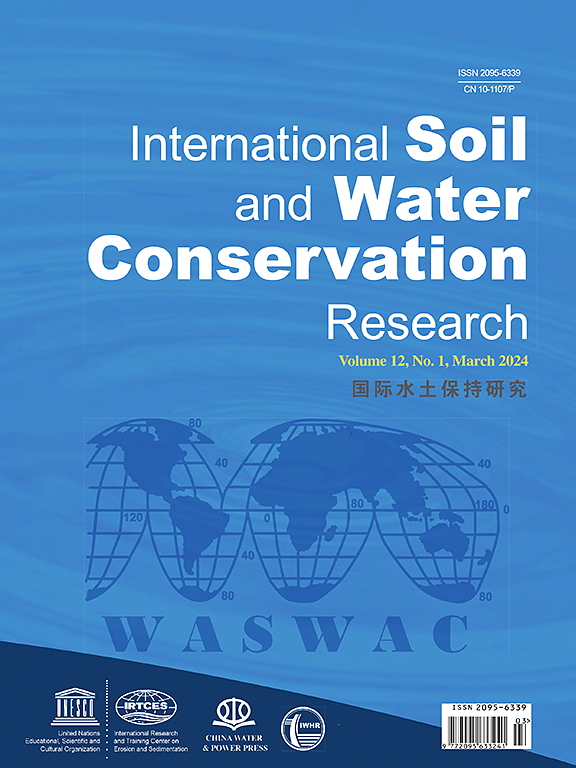Environmental assessment based on soil loss, deforestation in permanent preservation areas, and water quality applied in the Itacaiúnas Watershed, Eastern Amazon
IF 7.3
1区 农林科学
Q1 ENVIRONMENTAL SCIENCES
International Soil and Water Conservation Research
Pub Date : 2024-11-06
DOI:10.1016/j.iswcr.2024.11.001
引用次数: 0
Abstract
To understand how various environmental pressures may threaten the Amazon territory, specifically its hydrographic basins, it is crucial to guide key management actions such as soil conservation, environmental preservation, and forest restoration. This paper, based on a detailed study conducted in the Itacaiúnas River Watershed (IRW) located in the Carajás mining province—one of the most significant metallogenetic provinces globally and within the Arc of Deforestation in the Amazon—proposes a new index to assess environmental threats or vulnerabilities. The index evaluates soil loss, deforestation in permanent preservation areas, and water quality—key environmental issues in watershed management. Using geoprocessing and remote sensing techniques, we applied the index across the entire catchment area and at the beginning of the drainage network (a proxy for river springs). Our findings reveal that: i) 68% of unit catchments (32% of headwaters) exhibit “High” or “Very High” soil loss vulnerability; ii) 69% of unit catchments (32% of headwaters) have more than 20% of their permanent preservation areas deforested, representing the primary threat among the three criteria to the basin; iii) Only 4.7% of unit catchments (2% of headwaters) present any chemical risk related to water consumption. The combined criteria (simple arithmetic mean of normalized values) indicate that the east-central and southern parts of the watershed have higher index values, necessitating greater attention to soil conservation. In contrast, the center-western area of the basin, characterized by conservation units and indigenous land, showed low index values but remains at risk primarily due to soil loss if environmental preservation actions are not maintained.
基于土壤流失、永久保护区森林砍伐和亚马逊东部Itacaiúnas流域水质的环境评估
要了解各种环境压力如何威胁亚马逊地区,特别是其水文盆地,至关重要的是要指导关键的管理行动,如土壤保持、环境保护和森林恢复。本文基于对位于Carajás矿业省(全球最重要的成矿省之一)的Itacaiúnas河流流域(IRW)进行的详细研究,提出了一个评估环境威胁或脆弱性的新指标。该指数评估了土壤流失、永久保护区的森林砍伐和水质——流域管理中的关键环境问题。利用地理处理和遥感技术,我们将该指数应用于整个集水区和排水网络的开始(河流泉的代理)。我们的研究结果表明:1)68%的单位集水区(32%的水源)表现出“高”或“非常高”的土壤流失脆弱性;Ii) 69%的单位集水区(32%的水源)有超过20%的永久保护区被砍伐,在三个标准中对流域构成主要威胁;只有4.7%的单位集水区(2%的水源)存在与用水有关的化学品风险。综合指标(归一化值的简单算术平均值)表明,流域中东部和南部的指数值较高,需要加大对土壤保持的重视。相比之下,以保护单元和土著土地为特征的盆地中西部地区指数较低,但如果不采取环境保护行动,则主要由于土壤流失而仍然存在风险。
本文章由计算机程序翻译,如有差异,请以英文原文为准。
求助全文
约1分钟内获得全文
求助全文
来源期刊

International Soil and Water Conservation Research
Agricultural and Biological Sciences-Agronomy and Crop Science
CiteScore
12.00
自引率
3.10%
发文量
171
审稿时长
49 days
期刊介绍:
The International Soil and Water Conservation Research (ISWCR), the official journal of World Association of Soil and Water Conservation (WASWAC) http://www.waswac.org, is a multidisciplinary journal of soil and water conservation research, practice, policy, and perspectives. It aims to disseminate new knowledge and promote the practice of soil and water conservation.
The scope of International Soil and Water Conservation Research includes research, strategies, and technologies for prediction, prevention, and protection of soil and water resources. It deals with identification, characterization, and modeling; dynamic monitoring and evaluation; assessment and management of conservation practice and creation and implementation of quality standards.
Examples of appropriate topical areas include (but are not limited to):
• Conservation models, tools, and technologies
• Conservation agricultural
• Soil health resources, indicators, assessment, and management
• Land degradation
• Sustainable development
• Soil erosion and its control
• Soil erosion processes
• Water resources assessment and management
• Watershed management
• Soil erosion models
• Literature review on topics related soil and water conservation research
 求助内容:
求助内容: 应助结果提醒方式:
应助结果提醒方式:


